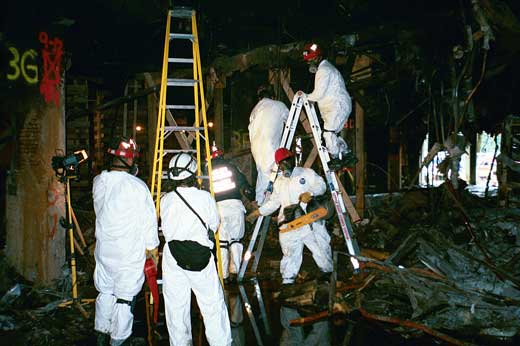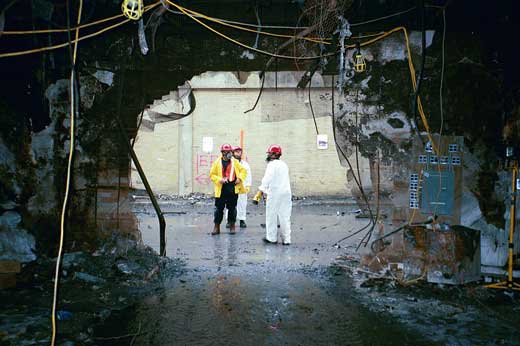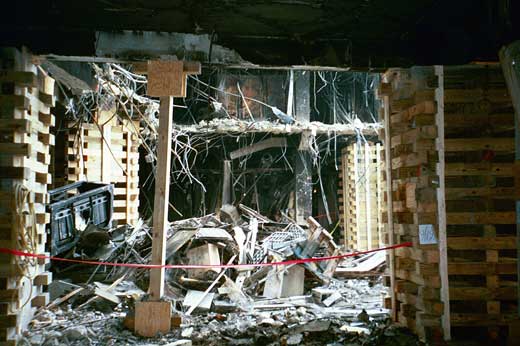Labs emergency management staff recalls 9/11 deployment

Much of the world was horrified and felt helpless by what was unfolding the morning of Sept. 11, 2001. The World Trade Center was attacked using hijacked commercial jets filled with innocent passengers. The Pentagon was attacked the same way minutes later, and then a fourth passenger jet was brought down in Shanksville, Pennsylvania.
Reactions ranged from grief to anger as people openly wept, anxiously paced, furiously dialed their loved ones and sought other ways to cope with the cataclysmic events, one after the next.
Jim Breen had his own reaction. At the time, Jim was a fire captain with Albuquerque Fire Department working his second 24-hour shift as he watched the news. He knew full well he would be called into service as a member of one of FEMA’s Urban Search and Rescue Teams, New Mexico Task Force-1.
“Everyone in the fire station immediately knew to get ready for the worst. There was no question in our minds that this was an attack,” recalled Jim, emergency operations manager for the Labs. “We went right to work getting our equipment ready for deployment.”
Despite his best efforts to stay focused, Jim felt a huge range of emotions spinning out of the morning’s events as they were being broadcast live across the nation.
Sandians answer the call

At least eight of Sandia’s current emergency management team members were called into service Sept. 16 to help with rescue and recovery efforts at the Pentagon as part of New Mexico’s urban search and rescue team. They removed tons of debris, helped stabilize the structure, recovered airplane parts and identified victims’ remains and gathered their personal effects.
The 70-member team reported to the site Sept. 18, 2001. After seven days, the scene was still shocking, Jim said. American Airlines Flight 77 had crashed into the west side of the Pentagon at 530 mph with more than 37,000 pounds of fuel. The aircraft penetrated 310 feet into the building and ignited a fire that severely damaged a large swath of the complex. Portions of the Pentagon collapsed within 40 minutes of impact and fires raged for more than 32 hours.
The team immediately began shoring up damaged structural columns and beams and removing the debris. Command and safety officers, search teams, medical teams, rescue teams, hazardous materials teams and heavy rigging specialists worked in concert to sift through and clear the debris. Jim and Robert Sanchez were responsible for team deployment and managed the rescue squad of four smaller specialist teams, including two heavy riggers to work with cranes.
“It was pretty intense work dealing with security checkpoints, hazardous materials and an unstable structure in waist-high debris,” Jim said. “And, of course, there was the emotional toll of securing the remains and personal effects of the victims.”
Emergency planner Rick Chadwick, an equipment operator and rigger with the team, distinctly remembers the solemn process that emerged as remains were located.

“When human remains were found, a U.S. Army infantry squad would step up in their Class A uniforms, white gloves and spit-shined shoes and march into the rubble in perfect formation, step and cadence,” Rick said. “Then they would come out of the structure in perfect formation carrying the remains, providing the utmost respect and dignity to every single victim.”
Each Sandia responder holds a distinct memory of their work at the Pentagon.
“The whole experience was surreal,” said emergency planner Troy Hamby. “It was so hard to process. We would find personal articles in that debris, like pictures from people’s desks, shoes or even stuffed animals, and would be overcome with a flood of emotions. Nothing could have prepared us for what we saw.”
Jim remembers coming across a single high-heeled shoe. “It struck me very powerfully,” he says. “This shoe was worn by somebody’s wife or mother or daughter and it was the biggest single item I saw that crystallized the human toll this attack had taken on the loss of life and opportunity of innocent people. It’s burned into my memory.”
20 years of reflection
After three grueling days of 12-hour shifts, New Mexico’s urban search and rescue team had completed its mission to remove debris and stabilize the site and was on its way home.
“The support from the citizens of New Mexico was overwhelming,” Jim said. “We received care packages and letters from school children, which made our work even more gratifying and purposeful amid all of the destruction and death.”
Troy said, “The reception we received upon returning to New Mexico was incredible. Our families were terrified while we were away, and it felt good to be back with them on familiar soil. I remember everyone being very proud of us.”
All told, 184 innocent people died, and 106 people were injured at the Pentagon that morning. “We were able to contribute to the response while most could only stand by and watch on the TV,” Jim said. “There was a great sense of purpose and determination knowing that being deployed was a position of honor. Given the circumstances, men and women came together and accomplished seemingly impossible tasks with resolve under extremely difficult conditions. What unites us makes us stronger and what divides us makes us weaker and more vulnerable.”